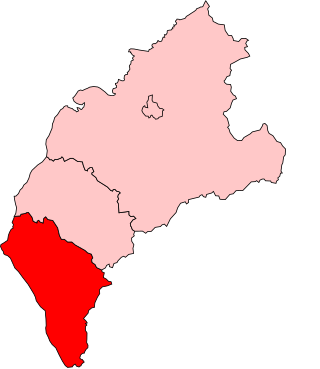
Windsor (/ˈwɪnzə/) is a constituency in Berkshire represented in the House of Commons of the UK Parliament since 2005 by Adam Afriyie of the Conservative Party. It was re-created for the 1997 general election after it was abolished following the 1970 general election and replaced by the Windsor and Maidenhead constituency.
Hallamshire was a Parliamentary constituency covering the Hallamshire district of England. The constituency was created in 1885 and abolished in 1918. The seat was a large geographical area which in the west included the moors of the Pennines, but came down from the hills in the centre to include better farmland north of Sheffield around Ecclesfield. In the north-east it included part of the South Yorkshire coalfield and some mining villages. In the south, the residents of Sheffield who owned their freeholds could vote in this division.

Abingdon was a parliamentary constituency in England, represented in the House of Commons of the Parliament of England until 1707, then of the Parliament of Great Britain from 1707 to 1800 and of the Parliament of the United Kingdom from 1801 to 1885. It elected one Member of Parliament (MP) from 1558 until 1983.
Frome was a constituency centred on the town of Frome in Somerset. It returned one Member of Parliament (MP) to the House of Commons of the Parliament of the United Kingdom from 1832, until it was abolished for the 1950 general election. Between 1832 and 1885, it was a parliamentary borough; after 1885 it was a county constituency, a division of Somerset.

Whitehaven was a constituency centred on the town of Whitehaven in Cumberland, which returned one Member of Parliament (MP) to the House of Commons of the Parliament of the United Kingdom.

West Riding of Yorkshire was a parliamentary constituency in England from 1832 to 1865. It returned two Members of Parliament (MPs) to the House of Commons of the Parliament of the United Kingdom.

East Norfolk was a constituency in the county of Norfolk that returned two members of parliament to the House of Commons of the Parliament of the United Kingdom from 1832 until 1868. It was re-established in 1885 with representation of one member. That seat was abolished in 1950.

East Cornwall was a county constituency in the House of Commons of the Parliament of the United Kingdom. It elected two Members of Parliament (MPs) by the bloc vote system of election.

East Cumberland is a former county constituency in the House of Commons of the Parliament of the United Kingdom. It elected two Members of Parliament (MPs) by the bloc vote system of election.

West Cumberland was a county constituency in the House of Commons of the Parliament of the United Kingdom. It elected two Members of Parliament (MPs) by the bloc vote system of election.
Finsbury East was a parliamentary constituency centred on the Finsbury district of North London, England. It returned one Member of Parliament (MP) to the House of Commons of the Parliament of the United Kingdom, elected by the first past the post system.
Cockermouth was the name of a constituency of the House of Commons of the Parliament of England in 1295, and again from 1641, then of the Parliament of Great Britain from 1707 to 1800 and of the Parliament of the United Kingdom from 1801 to 1918. It was a parliamentary borough represented by two Members of Parliament until 1868, and by one member from 1868 to 1885. The name was then transferred to a county constituency electing one MP from 1885 until 1918.

South Durham, formally the Southern Division of Durham and often referred to as Durham Southern, was a county constituency of the House of Commons of the Parliament of the United Kingdom. It elected two Members of Parliament (MPs) by the bloc vote system of election.

East Somerset was the name of a parliamentary constituency in Somerset, represented in the House of Commons of the Parliament of the United Kingdom between 1832 and 1918.
South East Durham was a county constituency represented in the House of Commons of the Parliament of the United Kingdom. It elected one Member of Parliament (MP) by the first past the post system of election between 1885 and 1918.
Andover was the name of a constituency of the House of Commons of the Parliament of England from 1295 to 1307, and again from 1586, then of the Parliament of Great Britain from 1707 to 1800 and of the Parliament of the United Kingdom from 1801 to 1918. It was a parliamentary borough in Hampshire, represented by two Members of Parliament until 1868, and by one member from 1868 to 1885. The name was then transferred to a county constituency electing one MP from 1885 until 1918.
Droitwich was the name of a constituency of the House of Commons of England in 1295, and again from 1554, then of the House of Commons of Great Britain from 1707 to 1800 and of the House of Commons of the Parliament of the United Kingdom from 1801 to 1918. It was a parliamentary borough in Worcestershire, represented by two Members of Parliament until 1832, and by one member from 1832 to 1885. The name was then transferred to a county constituency electing one MP from 1885 until 1918.
Stamford was a constituency in the county of Lincolnshire of the House of Commons for the Parliament of England to 1706 then of the Parliament of Great Britain from 1707 to 1800 and of the Parliament of the United Kingdom from 1801 to 1918. It was represented by two Members of Parliament until 1868 when this was reduced to one.
Denbigh District of Boroughs was a parliamentary constituency centred on the town of Denbigh in Wales. It returned one Member of Parliament (MP) to the British House of Commons.





